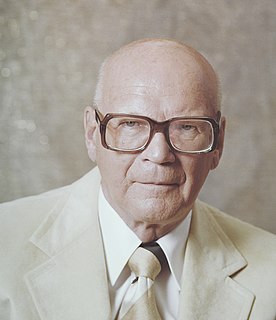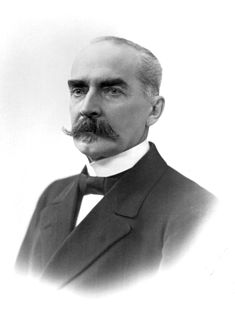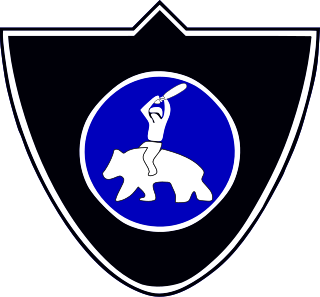
Urho Kaleva Kekkonen, often referred to by his initials UKK, was a Finnish politician who served as the eighth and longest-serving president of Finland from 1956 until 1982. He was the third and most recent president from the Agrarian League/Centre Party. As head of state for nearly 26 years, he dominated Finnish politics, held a large amount of power, won his later elections with little opposition and has often been classified as an autocrat. Nevertheless, he remains a respected figure.

Juho Kusti Paasikivi was the seventh president of Finland (1946–1956). Representing the Finnish Party and the National Coalition Party, he also served as Prime Minister of Finland. In addition to the above, Paasikivi held several other positions of trust, and was an influential figure in Finnish economics and politics for over fifty years.

Kaarlo Juho Ståhlberg was a Finnish jurist and academic, which was one of the most important pioneers of republicanism in the country. He was the first president of Finland (1919–1925) and a liberal nationalist.

Väinö Alfred Tanner was a leading figure in the Social Democratic Party of Finland, and a pioneer and leader of the cooperative movement in Finland. He was Prime Minister of Finland in 1926–1927.
The National Coalition Party is a liberal-conservative political party in Finland.

Patriotic People's Movement was a Finnish nationalist and anti-communist political party. IKL was the successor of the previously banned Lapua Movement. It existed from 1932 to 1944 and had an ideology similar to its predecessor, except that IKL participated in elections, although with limited success.

The Senate of Finland combined the functions of cabinet and supreme court in the Grand Duchy of Finland from 1816 to 1917 and in the independent Finland from 1917 to 1918.

The Paasikivi-Kekkonen doctrine was a foreign policy doctrine established by Finnish President Juho Kusti Paasikivi and continued by his successor Urho Kekkonen, aimed at Finland's survival as an independent sovereign, democratic, and capitalist country in the immediate proximity of the Soviet Union.
A minister without portfolio is either a government minister with no specific responsibilities or a minister who does not head a particular ministry. The sinecure is particularly common in countries ruled by coalition governments and a cabinet with decision-making authority wherein a minister without portfolio, while they may not head any particular office or ministry, may still receive a ministerial salary and has the right to cast a vote in cabinet decisions. In some countries where the executive branch is not composed of a coalition of parties and, more often, in countries with purely presidential systems of government, such as the United States, the position of minister without portfolio is uncommon.

The Agreement of Friendship, Cooperation, and Mutual Assistance of 1948, also known as the YYA Treaty from the Finnish Ystävyys-, yhteistyö- ja avunantosopimus, was the basis for Finno–Soviet relations from 1948 to 1992. It was the main instrument in implementing the Finnish policy called Paasikivi–Kekkonen doctrine.

Karl-August Fagerholm was Speaker of Parliament and three times Prime Minister of Finland. Fagerholm became one of the leading politicians of the Social Democrats after the armistice in the Continuation War. As a Scandinavia-oriented Swedish-speaking Finn, he was believed to be more to the taste of the Soviet Union's leadership than his predecessor, Väinö Tanner. Fagerholm's postwar career was, however, marked by fierce opposition from both the Soviet Union and the Communist Party of Finland. He narrowly lost the presidential election to Urho Kekkonen in 1956.

The war-responsibility trials in Finland were trials of the Finnish wartime leaders held responsible for "definitely influencing Finland in getting into a war with the Soviet Union and United Kingdom in 1941 or preventing peace" during the Continuation War, the Finnish term for their participation in the Second World War from 1941–1944. Unlike other World War II war-responsibility trials, the Finnish trials were not international. The trials were conducted from November 1945 through February 1946 by a special court consisting of the presidents of the Supreme Court of Finland, the Supreme Administrative Court of Finland, a professor from the University of Helsinki and twelve MPs appointed by the Parliament of Finland. The accused were convicted and were imprisoned until they were eventually paroled and then pardoned.
Parliamentary elections were held in Finland on 17 and 18 March 1945. The broad-based centre-left government of Prime Minister Juho Kusti Paasikivi remained in office after the elections.
Peace opposition was a Finnish cross-party movement uniting both bourgeois politicians like Paasikivi, Kekkonen, Sakari Tuomioja etc. and social democrats, aiming at stepping out of the Continuation war and finding a way to conclude peace with the Soviet Union. The number of MPs belonging to this group was rather small at first, but it gained influence as the military situation worsened. After the signing of armistice, Paasikivi established his cabinet, which included members of the previous opposition group.
Parliamentary elections were held in Finland on 7 and 8 March 1954.

Wilhelm Aleksander Thesleff was a Finnish general, first Minister of Defence of Finland and briefly the commander in chief of the Finnish army.
Juho Kusti Paasikivi's third cabinet was the 30th government of Republic of Finland. Cabinet's time period was from April 17, 1945 – March 26, 1946. It was Majority government.

Kekkonen's first cabinet was the 33rd government of Finland. The cabinet existed from 17 March 1950 to 17 January 1951. It was a minority government. The cabinet's Prime Minister was Urho Kekkonen.

The Social Democratic Party of Finland, shortened to the Social Democrats and commonly known in Finnish as Demarit, is a social-democratic political party in Finland. It is currently the largest party in the Parliament of Finland with 40 seats.
Two-stage presidential elections were held in Finland in 1950, the first time the public had been involved in a presidential election since 1937 as three non-popular elections had taken place in 1940, 1943 and 1946. On 16 and 17 January the public elected presidential electors to an electoral college. They in turn elected the President. The result was a victory for Juho Kusti Paasikivi, who won on the first ballot. The turnout for the popular vote was 63.8%. President Paasikivi was at first reluctant to seek re-election, at least in regular presidential elections. He considered asking the Finnish Parliament to re-elect him through another emergency law. Former President Ståhlberg, who acted as his informal advisor, persuaded him to seek re-election through normal means when he bluntly told Paasikivi: "If the Finnish people would not bother to elect a President every six years, they truly would not deserve an independent and democratic republic." Paasikivi conducted a passive, "front-porch" style campaign, making few speeches. By contrast, the Agrarian presidential candidate, Urho Kekkonen, spoke in about 130 election meetings. The Communists claimed that Paasikivi had made mistakes in his foreign policy and had not truly pursued a peaceful and friendly foreign policy towards the Soviet Union. The Agrarians criticized Paasikivi more subtly and indirectly, referring to his advanced age, and speaking anecdotally about aged masters of farmhouses, who had not realized in time that they should have surrendered their houses' leadership to their sons. Kekkonen claimed that the incumbent Social Democratic minority government of Prime Minister K.A. Fagerholm had neglected the Finnish farmers and the unemployed. Kekkonen also championed a non-partisan democracy that would be neither a social democracy nor a people's democracy. The Communists hoped that their presidential candidate, former Prime Minister Mauno Pekkala, would draw votes away from the Social Democrats, because Pekkala was a former Social Democrat. The Agrarians lost over four per cent of their share of the vote compared to the 1948 parliamentary elections. This loss ensured Paasikivi's re-election. Otherwise Kekkonen could have been narrowly elected President - provided that all the Communist and People's Democratic presidential electors would also have voted for him.













